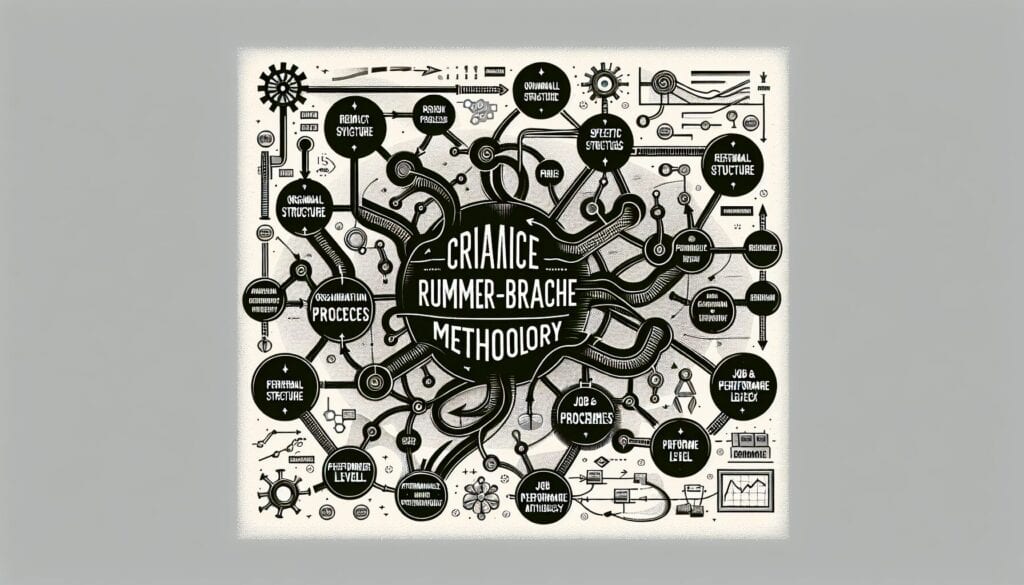A performance improvement methodology that focuses on viewing an organization as an adaptive system and managing performance at three levels: organizational, process, and job/performer.
- المنهجيات: العملاء والتسويق, الاقتصاد, لين سيجما, تصنيع, إدارة المشاريع, الجودة
Rummler-Brache Methodology

Rummler-Brache Methodology
- المنهجية الرشيقة, إعادة هندسة عمليات الأعمال (BPR), إدارة التغيير, التحسين المستمر, التصنيع اللين, التحول التنظيمي, تتبع الأداء, تخطيط العمليات, إدارة الجودة
الهدف:
كيفية استخدامه:
- Emphasizes understanding the "white space" between functional silos where processes often break down. Uses tools like process mapping and Human Performance System analysis to diagnose and improve performance.
الايجابيات
- Provides a comprehensive framework for performance improvement; links strategy, processes, and individual performance; helps identify and address systemic issues.
سلبيات
- Can be complex to implement fully; requires a systems thinking approach throughout the organization; may require significant training and cultural change.
الفئات:
- الموارد البشرية, إدارة المشاريع, الجودة
الأفضل لـ
- Improving organizational performance by systematically analyzing and aligning goals, processes, and individual job performance across the entire organization.
The Rummler-Brache Methodology is particularly effective in industries such as healthcare, manufacturing, finance, and technology, where process efficiency is pivotal for organizational success. During the planning and execution phases of projects, this methodology can be initiated by executives or operations managers looking to enhance alignment between strategic objectives and day-to-day operations. Participants generally include cross-functional teams composed of stakeholders from different areas of the organization, as it promotes collaboration and communication among various departments. Tools used in this methodology, such as process mapping, allow for visual representation of workflows, making it easier to identify bottlenecks and areas for improvement. Human Performance System analysis further aids in diagnosing problems by examining how individual behaviors impact overall performance. This systematic approach not only targets existing issues but also ensures that future initiatives are aligned with the organization’s long-term goals. The framework supports continuous improvement efforts, fostering a culture where feedback is integrated into performance reviews and project evaluations, thus encouraging adaptive strategies that can be implemented in real-time. As such, organizations employing this methodology often report enhanced employee engagement and accountability, as individuals understand how their performance directly influences organizational success.
الخطوات الرئيسية لهذه المنهجية
- Identify the organizational goals and objectives.
- Map current processes across functional silos.
- Analyze the "white space" between processes for performance breakdowns.
- Assess individual job performance related to processes.
- Identify systemic issues affecting organizational performance.
- Develop interventions targeting the identified issues.
- Implement process improvements and training initiatives.
- Monitor performance changes and adjust as necessary.
نصائح للمحترفين
- Conduct regular cross-functional reviews to surface hidden inefficiencies and align goals across silos.
- Utilize data analytics to identify performance gaps and quantify the impact of process changes on outcomes.
- Develop a culture of continuous feedback and open communication to mitigate resistance to change and enhance collaboration.
لقراءة عدة منهجيات ومقارنتها, نوصي باستخدام
> مستودع المنهجيات الشامل <
مع أكثر من 400 منهجية أخرى.
نرحب بتعليقاتكم على هذه المنهجية أو المعلومات الإضافية على قسم التعليقات أدناه ↓، وكذلك أي أفكار أو روابط متعلقة بالهندسة.
السياق التاريخي
1962
1970
1972
1980
1980
1986
1986
1960
1963
1970
1980
1980
1980
1986
1987
(إذا كان التاريخ غير معروف أو غير ذي صلة، على سبيل المثال "ميكانيكا الموائع"، يتم تقديم تقدير تقريبي لظهوره الملحوظ)















منشورات ذات صلة
جدول الإنتاج الرئيسي (MPS)
التخصيص الشامل
قمع التسويق
التدقيق التسويقي
مؤشر MAPO (حركة ومساعدة مرضى المستشفيات)
تخطيط موارد التصنيع (MRP II)